Fractures/Cast Care Instructions
Fractures
Introduction
Children are very active. They love to run, hop, skip, jump and tumble. Whether your child is an active athlete or just a toddler jumping on the bed, there's a good possibility that he or she will take a spill at home or on the playing field at some time. These falls are usually harmless. But, when a child sustains a significant fall or trauma the velocity of the fall combined with the pressure of hitting the ground could be enough to fracture, or break, a bone.
When a bone breaks a change in the normal alignment of the limb may occur with associated soft tissue damage and swelling of the limb. If not recognized and treated early the fracture is at risk for healing in a position that may alter function in the future.
Most children’s fractures, however, are at low risk for problems. Appropriate evaluation by an orthopaedic surgeon experienced in pediatric orthopaedic trauma will determine the nature of the skeletal (bone) injury, will provide counseling about treatment options, and will allow for longer term follow up to assess the outcome of the injuries.
Common Fracture Locations
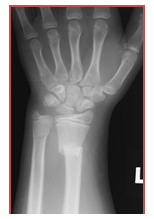
- Distal Radius/Ulna (wrist)
- Radial/Ulnar Shaft (forearm)
- Distal Humerus/Supracondylar (elbow)
- Humeral Condyle (elbow)
- Metacarpals & Phalanges (hand)
- Femoral Shaft (thigh)
- Tibial Shaft (leg)
- Distal Tibia/Fibula (ankle)
- Metatarsals & Phalanges (foot)
Children's bones heal faster than adult's bones. This has two important consequences. First, it means that a child with an injury should see a doctor as quickly as possible, so the bone gets the proper treatment before it begins to heal. Ideally, this means seeing an orthopaedic specialist within five to seven days of the injury, especially if manipulation to align the bone is required. Second, the period of immobilization required for healing will not be as long as for an adult.
To make the diagnosis, the doctor will examine the child and probably use X-rays to assess the alignment of the fracture. Occasionally, the doctor may request other diagnostic tests, such as magnetic resonance imaging (MRI), computed tomography (CT), or ultrasound.
Who's at Risk?
- Fractures occur twice as often in boys as in girls
- Injuries may occur in competitive sports, such as football, basketball, or gymnastics
- Fractures can result from a single traumatic event, such as a fall or automobile accident, or from chronic stress and overuse
Symptoms of a fracture include
- Any type of deformity in the limb
- Acute pain
- Tenderness
- Swelling
- An inability to rotate or use the limb in a normal manner
Treatment
Treatment depends on the type of fracture and the degree of displacement.
Nonsurgical Treatment
Some fractures may simply need the support of a splint or cast until they heal. If the bones do not break through the skin, the physician may be able to push (manipulate) them (Closed Reduction) into proper alignment without surgery. This may require an injection of a local anesthetic or having your child be sedated for the procedure.
Surgical Treatment
Surgery to align the bones and secure them in place may be required if:
- The skin is broken
- The fracture is unstable
- Bone segments have been displaced
- The bones cannot be aligned properly through manipulation alone
- The bones have already begun to heal at an angle or in an improper position
After the bones are aligned, the physician may use pins, metal implants, or a cast to hold them in place until they have healed.
A stable fracture may require three to four weeks in a cast. A more serious injury may need to be immobilized for six to twelve weeks.
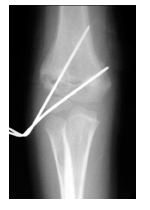
If the fracture disrupts the growth plate at the end of the bone, the physician will probably want to watch it carefully for several years to ensure that growth proceeds normally.
Closed Reduction (realigning the bone) and placing the fractured (broken) limb in a cast is the most common way to that a child’s fracture is treated.
Occasionally the attempt to realign the bone is unsatisfactory or the fracture cannot be reduced. In these instances an open reduction (realigning the bone through an incision on the limb) in the operating room with anesthesia may be necessary and the bone may be held in place with metal implants (wires, screws, plates or rods).
Remodeling
The bone will straighten as it grows. The remodeling process may continue until (and beyond) skeletal maturation in response to constantly changing stress patterns imposed by continued growth and development. The degree of remodeling is greater in younger children, who have an immense capacity for growth and change. The following example is not a growth plate fracture, but it demonstrates the enormous remodeling potential of a child.
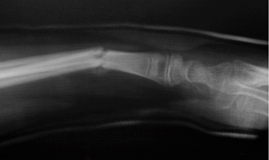
Healed Fracture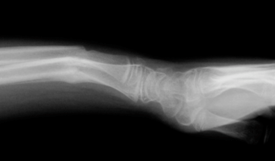
3 Months after Injury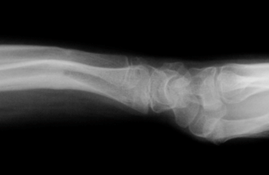
6 Months after Injury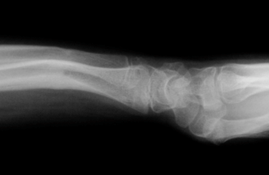
1 Year after Injury
Summary
Children’s fractures must be watched carefully to ensure proper long-term results.
Regular follow-up visits to the doctor may continue for at least a year after the fracture.
Patients whose fractures are treated with a metal implant may need a separate procedure to remove the implant. Removal of the orthopaedic implant may be done in the clinic or in the operating room (depending on the type of implant used). This is typically performed after an adequate amount of fracture healing has occurred.
Cast Care Instructions
What is a cast?
A cast is a hard splint that completely encloses part of an injured arm or leg in the best position for healing. The purpose of a cast is to prevent all movement and protect a broken bone or torn ligament until it heals. The inner layer of a cast is cotton padding to protect the skin. The cast itself can be made out of plaster or fiberglass.
How can I take care of my child?
- Elevation - If the leg is injured, elevate the leg on pillows for at least the first 24 hours. This will limit the amount of swelling that occurs. If the arm is injured, your child should keep the injured part elevated above the heart to limit swelling. Occasional wiggling of the fingers or toes will also prevent some swelling.
- Pain Relief - A prescription for pain medicine may have been provided. Continue this for at least the first 48 hours as instructed for moderate to severe pain. If your child has mild pain you may give him/her Tylenol (acetaminophen) as directed on the medication bottle.
- Checking the Skin - Check the skin around all cast edges each day for redness, swelling or sores. Check for swelling and color changes by comparing the casted limb with the unaffected side.
- Bathing - To keep from getting the cast wet, use a washcloth and washbasin to sponge bathe. Always cover the cast with a plastic wrapping to protect it when you are going to be around water, even when it is raining. Enclosing the cast in a plastic bag for a bath or shower usually doesn't work. Don't get the cast wet. Wet plaster can become soft and crumble. Wet padding under a fiberglass cast can cause skin rashes. If the cast becomes wet, dry it with a hair dryer on the cool setting. Do not put any powders or lotions inside the cast.
- Itching - Don't stick anything down into the cast, such as a coat hanger or other device, to scratch an itch. It might injure the skin and cause an infection. Tapping on the cast to create a vibration may be helpful. A blow dryer on the cool setting is helpful. You may give your child Benadryl (diphenhydramine) as directed on the medication bottle if the itching persists.
- Walking - If the cast is on a leg, don't let your child walk on it unless you have your healthcare provider's approval. Follow the instructions provided for putting weight on the broken leg.
- Activities - Children with casts can go to school and play. However, they need to avoid riding a bike or playing any hard sports. Avoid swimming and other activities that might get the cast wet.
- Cast Odor - The cast will NOT be changed because of odor. It is not unusual for the cast to have an odor due to the fact that you cannot bathe the area. Do not apply powders or perfumes in or on the cast, this does not help the odor and may irritate the skin.
What are the signs of a tight cast?
If the cast is too tight, it can decrease circulation in the fingers and toes. The most common symptoms of a cast that is too tight are the following:
- Your child feels numbness, tingling, or increased pain
- The fingers or toes turn to a different color (pale or bluish) than the color of the fingers or toes of the non-injured arm or leg
- Swelling of toes or fingers
When does my child need to be seen again?
Most children who have a cast need close follow-up.
Call for your next appointment in ________week(s)
Ortho Clinic or if you are to be seen in the office.
When should I call my child's healthcare provider?
Call the nurse line at or the Ortho Clinic or office Call IMMEDIATELY if:
- Your child feels numbness, tingling, or increased pain
- The fingers or toes turn a different color (pale or bluish) than the color of the fingers or toes of the non-injured arm or leg
- The fingers and toes become swollen
- Your child has trouble moving the fingers and toes of the arm or leg that has a cast on it
- Pain under the cast becomes severe and pain medicines do not help
- Any drainage comes through or out of the end of the cast
- A bad odor comes from underneath the cast
- You notice a stain or area of warmth on the cast
- Your child develops a fever
- The cast feels too loose or too tight
- The cast becomes soft or breaks
- You have a fiberglass cast that doesn't feel dry in 4 or 5 hours after getting it wet
- You have a plaster cast and it gets wet
